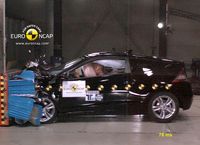Honda CR-Z Is One Of Europe’s Safest Cars - VIDEO ENHANCED
SLOUGH, UNITED KINGDOM – Aug 26, 2010: The Honda CR-Z has been rated one of Europe's safest cars, achieving a maximum 5-stars in the latest independent crash testing results from Euro NCAP.
Euro NCAP’s rating scheme focuses on the vehicle’s overall safety performance which gives consumers an easy to understand single score. The system considers occupant protection in frontal, side, pole and rear impacts, child protection, pedestrian protection and the availability of driver aids.
The rating scheme uses a weighted score, combining many aspects of a car’s safety performance: adult (50%), child (20%) and pedestrian (20%) protection assessment results with the availability of safety assistance devices (10%). To qualify for inclusion, safety assistance devices (VSA for Honda) must be fitted as standard across 90% of the EU 27 2010 model range.
The CR-Z is the latest in a series of Honda cars to receive top marks. Since the introduction of the new rating scheme, Euro NCAP has tested four other Honda models; Civic, Accord, Jazz and most recently, Insight. All five models achieved 5 stars, with the Honda Insight also being named “safest hybrid vehicle” as well as the 2nd safest vehicle tested during 2009.
Euro NCAP's new assessment reflects Honda’s commitment to overall vehicle safety, complimenting Honda’s long standing in-house safety testing which seeks to improve real world safety. Honda’s car-to-car crash test facility at the Tochigi R&D centre analyses impacts between models of different sizes and weights and develops solutions to mitigate injuries for both for passengers and pedestrians. The omni-directional vehicle-to-vehicle crash test facility opened in 2001 and is the world's first indoor all-weather facility of its type.
Click PLAY to watch the CR-Z crash test video
Safety in the Honda CR-Z
Vehicle Stability
Assist
Vehicle Stability Assist (VSA) is designed to assist the
driver in maintaining control during cornering, acceleration and sudden
manoeuvres by applying braking assistance to any of the wheels as necessary
and modulating the engine torque output as required.
Braking
14-inch ventilated front and solid rear disc brakes
ensure road stability, which is further enhanced by the Anti-lock Braking
System (ABS), Electronic Brake-force Distribution (EBD) and Brake Assist
(BA).
Advanced Compatibility Engineering (ACE)
Developed in the
car-to-car crash testing facility at Tochigi, the Advanced Compatibility
Engineering™ (ACE™) body structure is now a well-established
strength of Honda’s safety credentials.
The ACE™ body structure is a Honda exclusive body design that enhances occupant protection and crash compatibility in frontal collisions. The ACE design utilises a network of connected structural elements to distribute crash energy more evenly throughout the front of the vehicle. This enhanced frontal crash energy management helps to reduce the forces transferred to the passenger compartment and can help to more evenly disperse the forces transferred to other vehicles in a crash.
Pedestrian Protection
The CR-Z also incorporates many features
designed with pedestrian-protection in mind. Research has shown that these
features can dramatically improve a pedestrian's chance of survival if
struck by a moving vehicle. Features include windscreen wiper pivots
designed to break away on impact, energy absorbing front wing mounts and
bonnet hinges, as well as an unobstructed area beneath the bonnet allowing
greater space for deformation.
Airbags and Seatbelts
On all models in the range, the driver
and passenger Supplemental Restraint System (SRS) front and side airbags
are complemented by full length curtain airbags to protect all occupants.
There are three-point Emergency Locking Retractor (ELR) seatbelts in all
seating positions, the front seatbelts also have two stage Energy
Absorption (EA) load limiting pre-tensioners. Additionally in the rear
ISOFIX points ensure secure and correct installation mounting of child
seats.
Active headrests
The CR-Z is equipped with front seat active
headrests which reduce the likelihood of neck injury in rear impacts. As
the occupant is pushed against the seat back, a rigid plate in the seat
presses a link to the headrest pushing it up and forward to support the
head.



